Would you look at that? After rounds of edits, multiple cups of coffee, and lots of hard work, you’re finally done with your article! The only issue is that you have no idea what your headline should be. I’ve been in your shoes, and the headline headaches are a real thing.
Maybe you’re an experienced journalist, or maybe you’re just trying to expand your writing repertoire. Either way, you’ve come to the right place. In this article, we’ll lay out newspaper headline examples, help you understand why they’re so important, and give you an actionable framework for how to write news headlines.
Download This List of Awesome Headline Words
Before you jump head-first into some examples and writing strategies for headlines, download this list of great headline words we’ve composed for you in an easily downloadable PDF.
The key to crafting an awesome headline is using the right words, so use some of these to increase your traffic!
Why Do Headlines Matter?
On average, eight out of ten people will only read your headline, and two out of those ten will read your body copy. This is what makes having a great headline so important.
If you can write a headline that makes people want to read, you can change this ratio to work to your advantage. Without a compelling headline to draw your readers in, your content will be left to the dark corners of the web. News headlines are especially important because they are your first chance to frame the narrative you’re weaving, but headlines — in all contexts — are the most important part of your content.
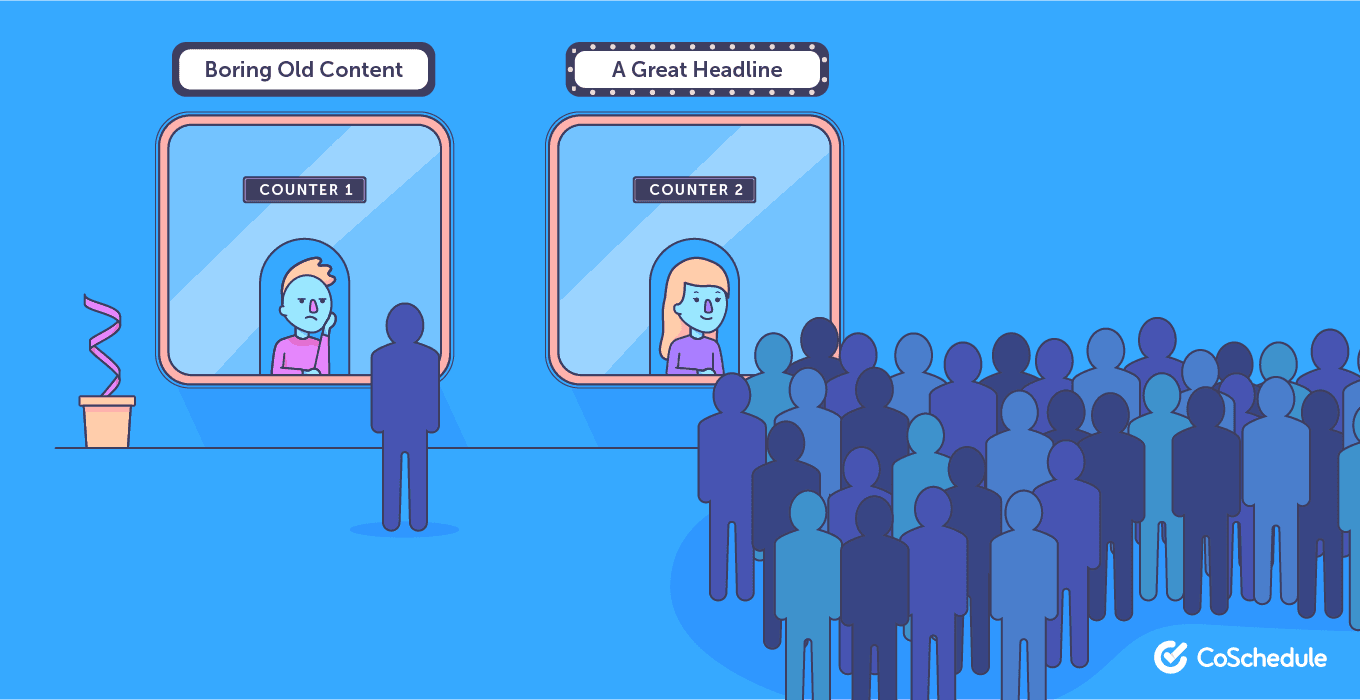
How Do We Define News Headlines?
To start, we should have a solid definition of a newspaper headline. I’m sure you have some examples that come to mind, but the most common definition is simply the text at the top of the page, which describes a story and gives the reader a chance to decide whether or not to read.
For our purposes, we will define newspaper headlines as the text preceding and describing a story in any context, not just print news articles.
With this in mind, we can take a look at some great examples on which we can build our own headlines.
Our Newspaper Headline Hall of Fame
Note that this is a collection of memorable headlines in different styles. As far as we know, there is no actual newspaper headline hall of fame.
“MEN WALK ON MOON”
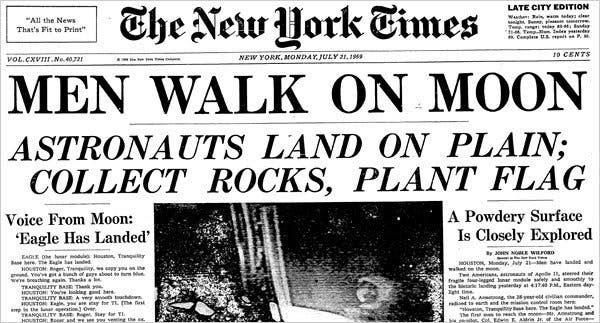
Source: The New York Times
This historic headline — published by The New York Times on July 21, 1969 — is a perfect example of sticking to the facts. Just a day after the moon landing, this headline tells readers exactly what happened but keeps it simple.
It forces its audience to dig into the body copy in order to get the entire story.
“WAR! OAHU BOMBED BY JAPANESE PLANES”
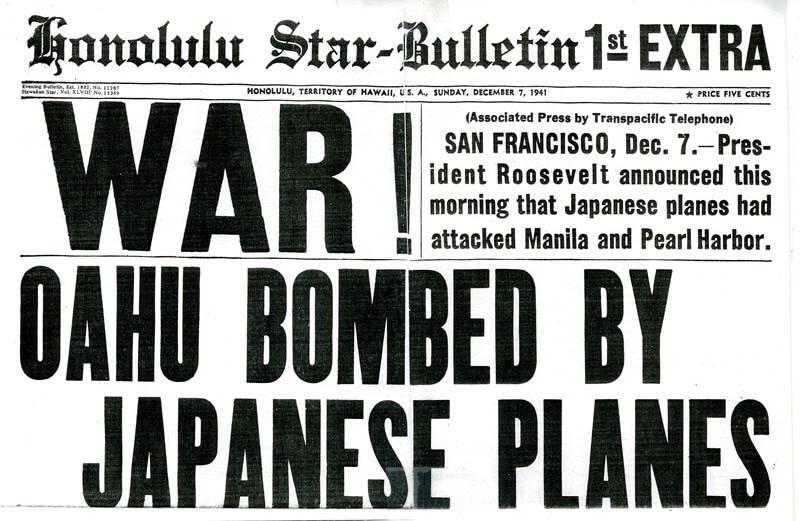
Source: The American Legion
This headline from the Honolulu Star-Bulletin on December 7, 1941 — a day after the Pearl Harbor attacks — much like our last example, tells the story of what happened in as few words as possible and sticks to the facts.
What makes this newspaper headline stand out, however, is that it also explains the ramifications of the event. By starting the headline with “War,” it is clear to the reader that there will be significant change in the coming days, and that it is likely the U.S. is preparing for war.
“DEWEY DEFEATS TRUMAN”
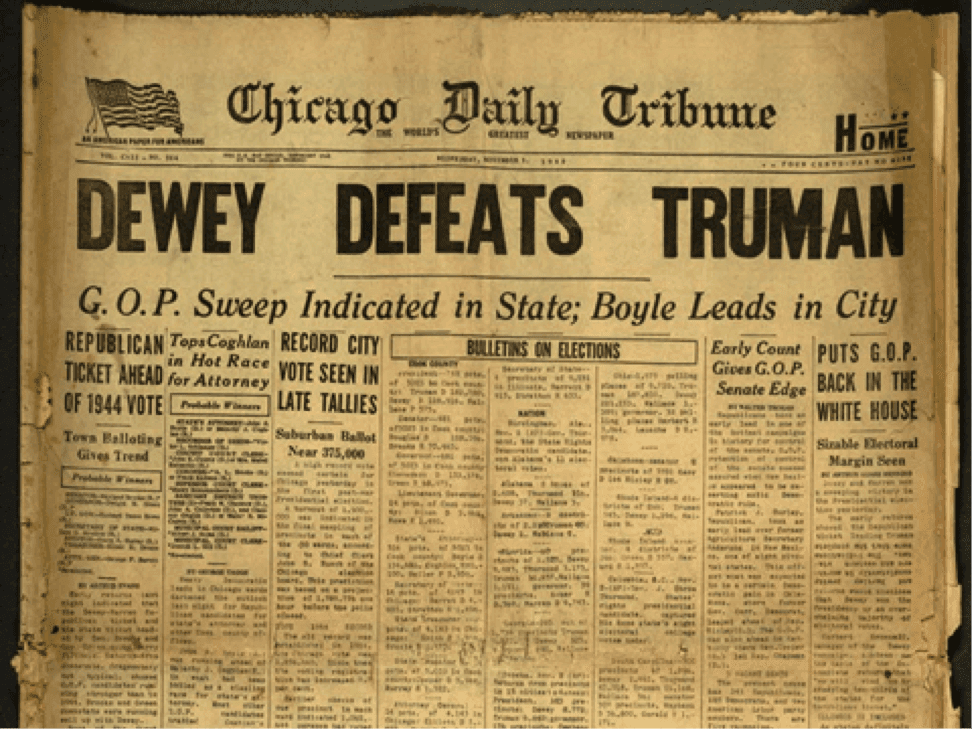
Source: Twitter
This should probably be categorized under infamous headlines, but for the sake of this post, we’ll allow it. This newspaper headline, published by the Chicago Daily Tribune on November 3, 1948, is a classic newspaper headline; keeping it simple and to the point.
What makes this headline interesting is that it’s 100% false.
This is an example of a media organization looking to break news before anyone else, and it serves as a good lesson to us.
Always make sure you confirm your facts before running with a story. You don’t want your readers to end up like this.
“DR. EINSTEIN IS DEAD; HE UNLOCKED THE DOOR TO ATOMIC AGE…”
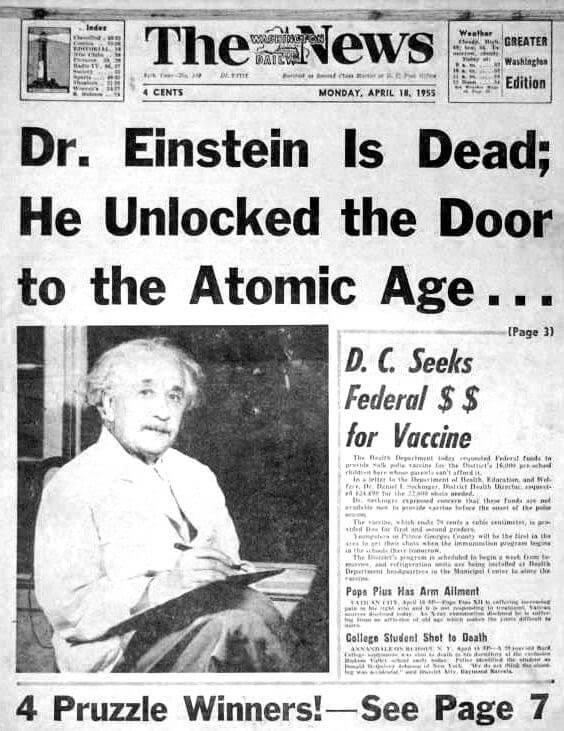
Source: Twitter
This headline from The Washington Daily News on April 18, 1955, is a great example of how to draw your readers into an article while also maintaining factuality. It explains the situation and then provides some context for less-informed readers.
By ending on an ellipses, it implies that there is more to know — encouraging readers to continue reading the story.
“STAY AT HOME”
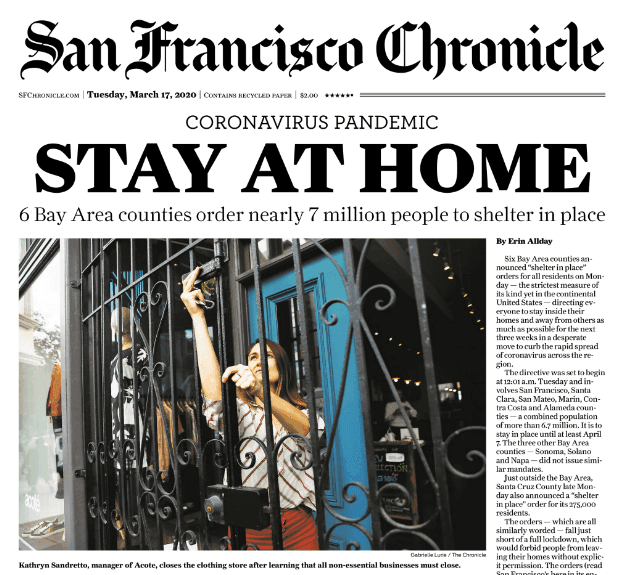
Source: San Francisco Chronicle
This headline is from the San Francisco Chronicle and was published on March 17, 2020; just as the Coronavirus pandemic hit America. This news headline is repeating the advice of health experts at the time, since most cities in the U.S. were going into lockdown.
This is a good example of using the headline to pull out the most important and actionable piece of information from the article — a good strategy when there is highly important information within.
“BUFFALO BILL GOES ON THE WAR PATH”
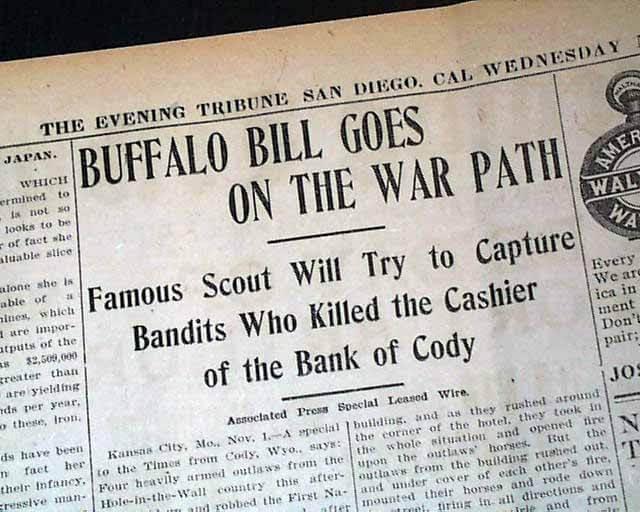
Source: Rare Newspapers
This headline is from the San Diego Evening Tribune. It dates all the way back to November 2, 1904, and it’s a great example of storytelling in newspaper headlines.
The imagery of Buffalo Bill setting off on a war path is sure to get readers invested in the story and allows the writer to act as a storyteller, which makes for great content.
“THE FORGOTTEN PEOPLE FIGHTING THE FOREVER WAR”
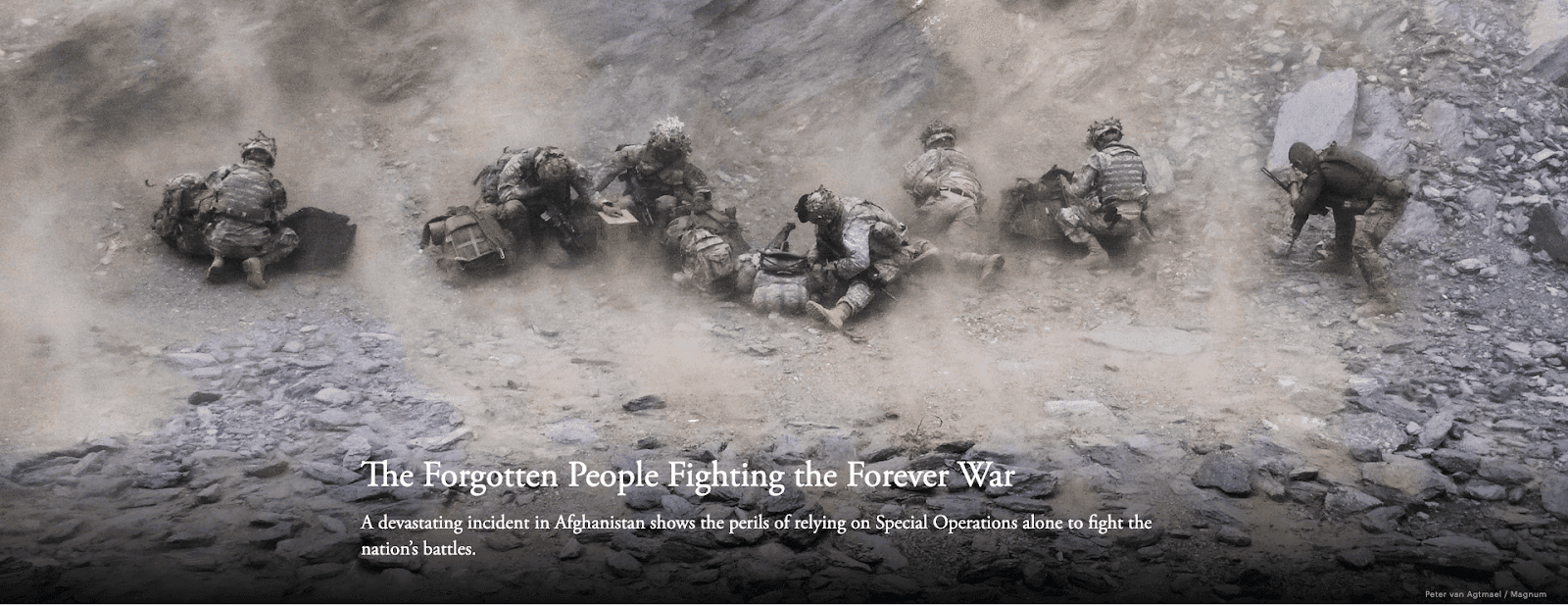
Source: The Atlantic
This headline is from an Atlantic article posted on January 23, 2021, about special operatives in Afghanistan. The way this headline is worded is sure to attract a reader’s interest, as it clearly lays out that it’s a person-centric article on war, while still not giving away too much information.
This type of headline is better suited for the internet; where it’s important to catch your audience’s attention and pull them into the story with strong storytelling.
7 Steps to Writing Headlines
With these headline examples fresh in our minds, we can begin to design a process that will guide us through writing our own hall-of-fame headlines.
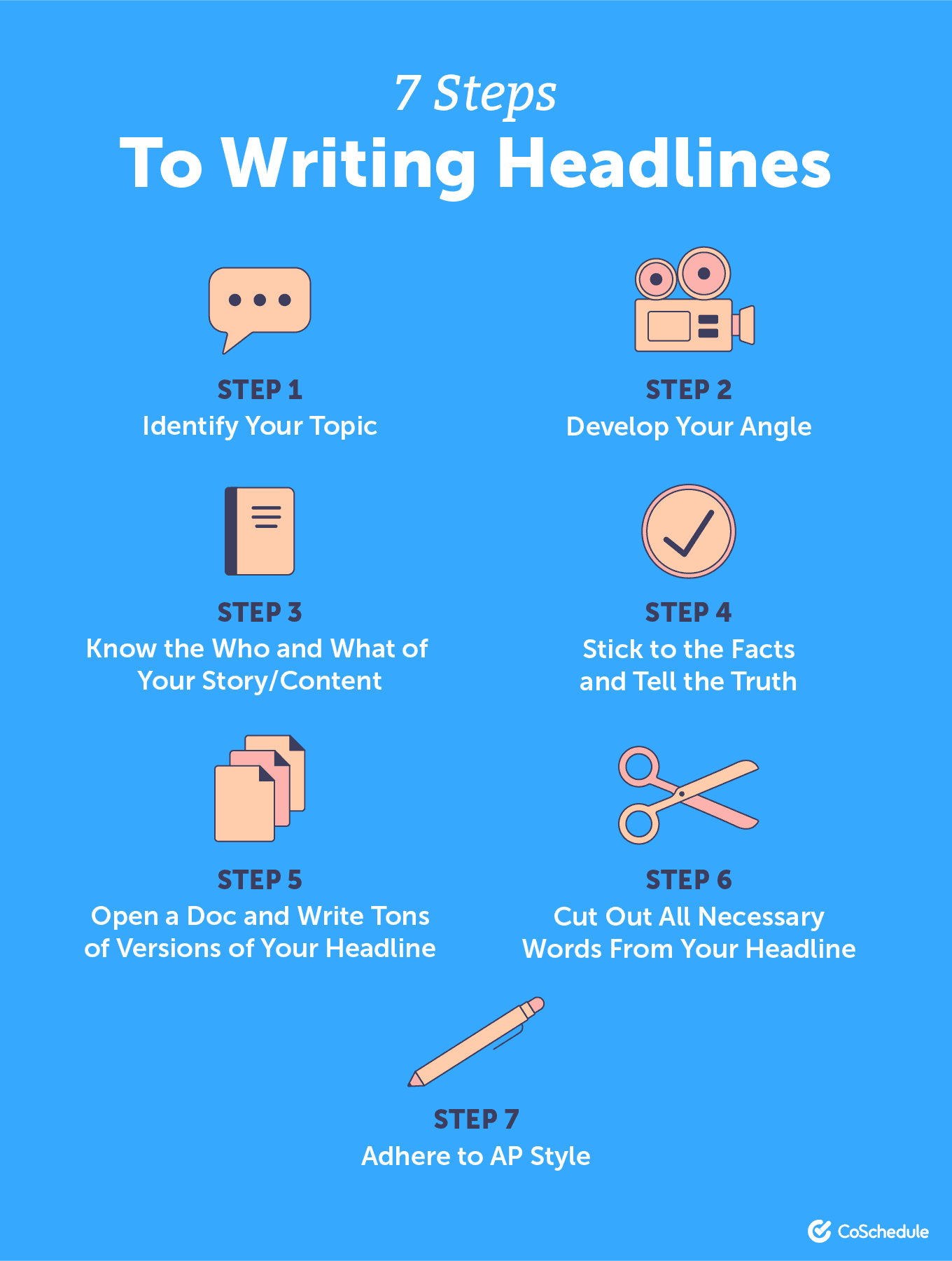
Step 1: Identify Your Topic
One of the most common mistakes made when writing newspaper headlines is including a headline that is unrelated or misrepresents the content within the story.
It’s crucial that your headline is a clear and accurate representation of your topic and the content within your article. Otherwise, your readers won’t trust you to provide the information they’re looking for.
You should ask yourself, “As a reader, what do I expect this article to be about — based solely off this headline?” If your content does not match your answer, you have more work to do.
Step 2: Develop Your Angle
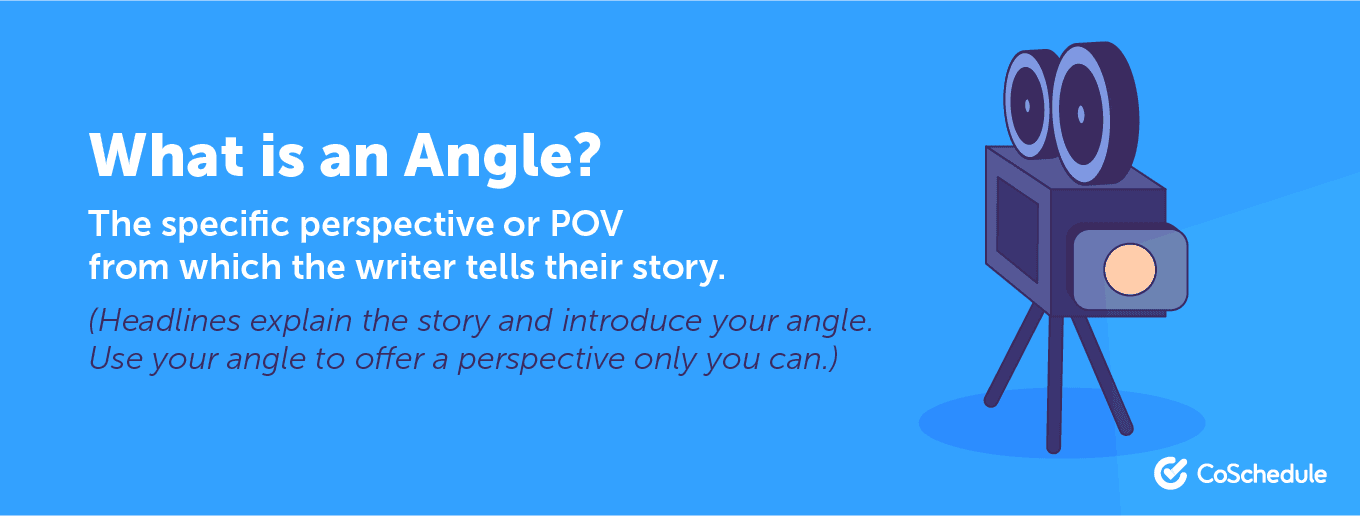
Each story has an angle. In a world with so much information on any subject available at the push of a button, what sets your story apart from all the similar stories? It’s important to identify and use your headline to make that angle clear from the start.
This can be accomplished by answering the question, “What take on this story am I giving that sets it apart from others?” The answer should be clear when reading your headline, and this will give your readers a reason to click on your post as they’re scrolling through search results.
Step 3: Know the Who and What of Your Story/Content
One of the most important parts of your newspaper headline is crafting it to appeal to your audience. If your headline doesn’t make your target audience want to read — so they can find out more — you’re doing it wrong.
You should ask yourself, “Who is this content for, and what do they want to know?” and “Who is this content about, and what is important to know about this topic?”
If you can answer these questions in your headline, it will make it easy for your audience to invest their time into reading your article.
Step 4: Stick to the Facts and Tell the Truth
This step is vital in the internet age.
As you know, many content creators are alright with advertising their content as something it’s not. These creators are being dishonest, and modern audiences can smell dishonesty from a mile away. While it may gain some clicks, the blow to your credibility as a source of information will make sure they won’t come back to your site the next time they have a question.
The headline is like an advertisement for your article. Ask yourself, “Is this headline truthful to the content within?”
A good exercise for this is to sit down and write out all the facts about your article. What do you cover? What is the important information? If you write down the truth, you will be left with great information that you can include in your headline or subheadings for your article.
Step 5: Open a Doc and Write Tons of Versions of Your Headline
We usually recommend that you write 20–25 versions of your headline before you choose the perfect one. This may seem tedious, but it will result in some great headline ideas and speed up the process for your next brainstorm.
If you’re feeling bogged down, try these headline formulas and templates or these seven fun and easy headline writing exercises.
Once you have more headlines than you know what to do with, try feeding your best headlines into CoSchedule’s Headline Analyzer Studio. This data-driven tool compares your headline against millions of other headlines and gives you a score, along with actionable tips and information on how to improve your headline.
This tool is not only a great way to hone your headlines, it is also really fun to play around with and try to get the highest score possible.
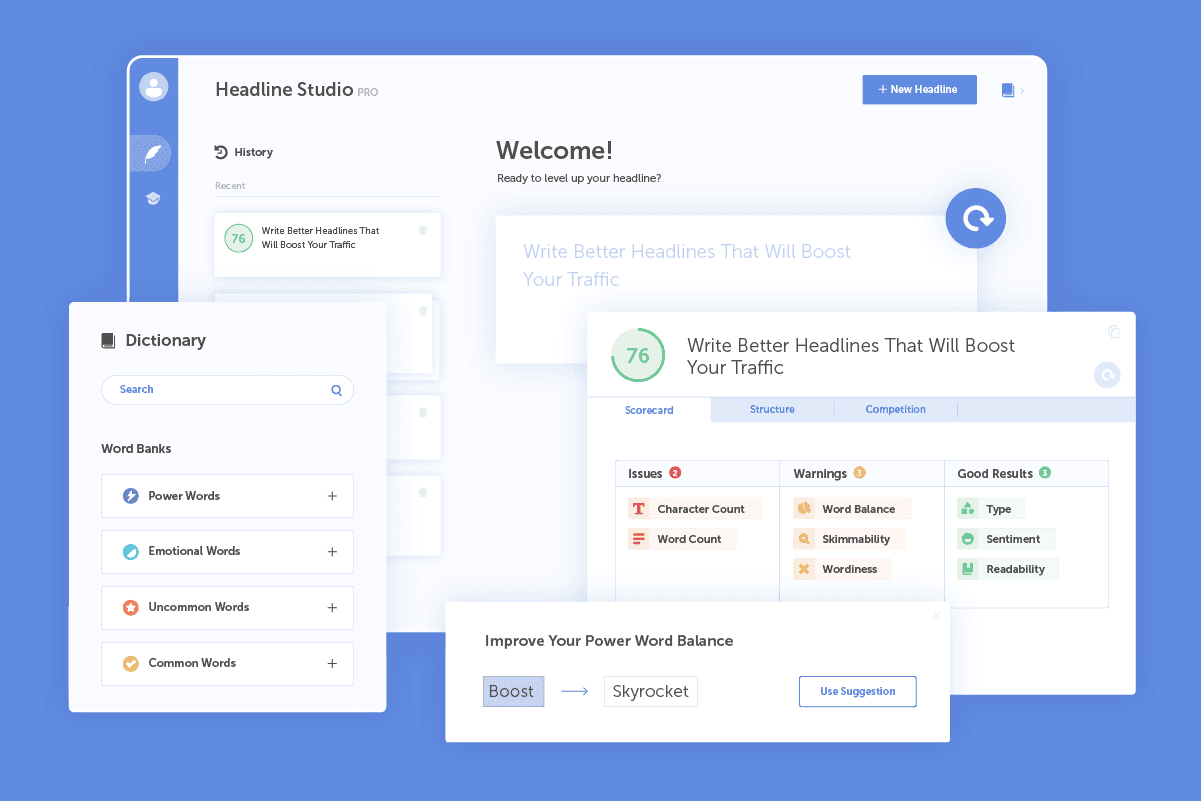
Simply type your headline into the analyzer and watch our carefully compiled data-based algorithm score your headline and recommend improvements. Try it now and see why marketers love what Headline Analyzer Studio has to offer.
Step 6: Cut Out All Unnecessary Words From Your Headline
This one should be fairly self-explanatory, but it is a vital part of newspaper headlines. The goal of journalism is often to pack as much information as you can into as little space as possible. For this reason, your headline should contain only the essentials.
Try removing unnecessary words from your headline — specifically words that don’t contribute to meaning, or those that can be replaced by stronger and more meaningful words.
This is a great time to use the Headline Analyzer’s word banks to find emotional, powerful words to add to your headline. You should also try shortening phrases as you work through your headlines. You want it to introduce your content as concisely as possible without losing any meaning.
For example, the headline “Astronauts Neil Armstrong and Buzz Aldrin take first steps on the moon as the world watches” sounds good, but shortening it to “Men walk on moon” gives all the necessary information and pushes the reader to look at the body copy for the full story.
Step 7: Adhere to AP Style
The Associated Press Stylebook is updated yearly, and it’s a great guide for all journalists to adhere to.
One main point of AP Style to keep in mind for writing newspaper headlines is to only capitalize the first word and all proper nouns in a headline. Following AP Style will give you solid guidelines for your writing, which you can refer to whenever you have questions or are unsure about certain rules.
You should also follow the four U’s of headline writing:

What Can Content Marketers and PR Professionals Learn From News Headlines?
Since news headlines are a unique way to label your content, there are a few different things you can take away from crafting your own.
Make Your Content Relevant to Audiences and Consider Making It Evergreen
Your content must be timely, or your audience will have no reason to engage. For example, a blog about how to adjust your work life to social distancing and working from home would have gotten lots of attention during the beginning of the COVID-19 pandemic, but if you wrote that same blog post now, it would likely see little to no attention.
This is why you should make both timely pieces along with evergreen content, which is content that never goes out of date. This blog post is a good example. As long as the information is updated and people still need to write newspaper headlines, this post will continue to have an audience.
For another example, the article The 50 Most Essential Marketing Skills You Need to be Successful in 2021 on the CoSchedule blog is a timely blog post. It was posted at the end of 2020 and contains content specifically geared toward supporting marketers in 2021. Beyond that, it doesn’t have much use for our audience.
An evergreen article, such as How to Emotionally Support Your Customers Through Content, on the other hand, contains content which won’t go out of date. At most, it will need an update once a year, but this is content you can continue to promote to your audience because it does not have a specific time stamp on it.
Make It Relevant
Your topic’s relevance to your audience is another key to take into consideration before you write.
When you read through your content, ask yourself, “If I were a member of my ideal audience, would I care about this information?” You should also take time to consider exactly what you want your audience to take away from your content. How will your post help them?
Along with relevance to your audience, you should also keep in mind the topic’s relevance to your brand or industry. Ask yourself, “Does my brand have the authority to speak on this issue?” Consider this factor when deciding what to write about, or you will find yourself with lots of content and advice that no one really trusts you to give.
Give It an Interesting Angle
If you take anything away from this article, make it this: whatever story you write, find an interesting angle that only you are able to speak on. This way, you can talk about topics that have already been discussed and still have relevant information to provide.
A great example of this comes from our headline hall of fame with the article, The Forgotten People Fighting the Forever War.

This headline offers limited information on the exact people and war the article is discussing, but once you read the body copy, we can see that the article is about special forces units in Afghanistan — specifically one group of soldiers that were a part of a major military blunder for the United States.
The article uses this specific example to put a spotlight on broader issues facing the U.S. military and special operative units in Afghanistan. This broad spotlight is the topic of the story, but by finding an interesting and specific angle, the writer is able to draw in readers and provide a perspective you’d be hard-pressed to find anywhere else.
When people search for information, they are looking to be informed, but also to find new perspectives on a topic. Trust yourself as an expert within your field, and provide your readers with a perspective they may not find anywhere else.
With all this in mind, the most applicable lesson from news writing which you can apply to your job as a content marketer is to stick to the facts. By sticking to the facts, you can ensure that your content and advice will always be applicable to your audience. It is also your responsibility as a content creator to distribute accurate and actionable information, and the best way to do this is to share only factual advice.
What Have We Learned?
In this article, we discussed what newspaper headlines are and why they’re important, went over some notable headlines from history, developed guidelines for writing great news headlines, and connected those newspaper headline ideas to the work of content marketers and PR professionals.
Now, it’s up to you to put this information into action by writing killer headlines for all your content.
Let’s get to work!

